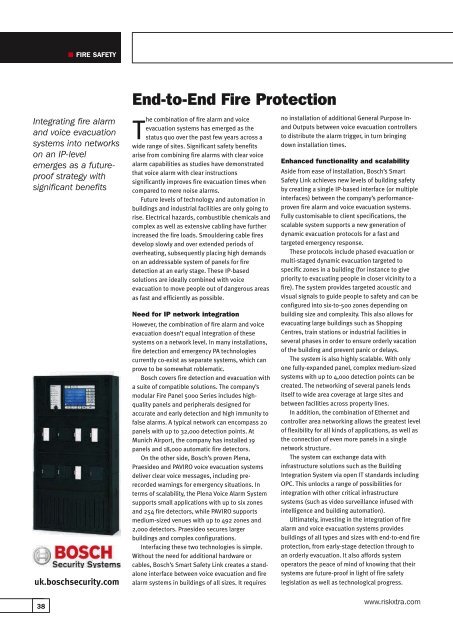RiskXtraSeptember2018
Create successful ePaper yourself
Turn your PDF publications into a flip-book with our unique Google optimized e-Paper software.
FIRE SAFETY<br />
End-to-End Fire Protection<br />
Integrating fire alarm<br />
and voice evacuation<br />
systems into networks<br />
on an IP-level<br />
emerges as a futureproof<br />
strategy with<br />
significant benefits<br />
uk.boschsecurity.com<br />
38<br />
The combination of fire alarm and voice<br />
evacuation systems has emerged as the<br />
status quo over the past few years across a<br />
wide range of sites. Significant safety benefits<br />
arise from combining fire alarms with clear voice<br />
alarm capabilities as studies have demonstrated<br />
that voice alarm with clear instructions<br />
significantly improves fire evacuation times when<br />
compared to mere noise alarms.<br />
Future levels of technology and automation in<br />
buildings and industrial facilities are only going to<br />
rise. Electrical hazards, combustible chemicals and<br />
complex as well as extensive cabling have further<br />
increased the fire loads. Smouldering cable fires<br />
develop slowly and over extended periods of<br />
overheating, subsequently placing high demands<br />
on an addressable system of panels for fire<br />
detection at an early stage. These IP-based<br />
solutions are ideally combined with voice<br />
evacuation to move people out of dangerous areas<br />
as fast and efficiently as possible.<br />
Need for IP network integration<br />
However, the combination of fire alarm and voice<br />
evacuation doesn’t equal integration of these<br />
systems on a network level. In many installations,<br />
fire detection and emergency PA technologies<br />
currently co-exist as separate systems, which can<br />
prove to be somewhat roblematic.<br />
Bosch covers fire detection and evacuation with<br />
a suite of compatible solutions. The company’s<br />
modular Fire Panel 5000 Series includes highquality<br />
panels and peripherals designed for<br />
accurate and early detection and high immunity to<br />
false alarms. A typical network can encompass 20<br />
panels with up to 32,000 detection points. At<br />
Munich Airport, the company has installed 19<br />
panels and 18,000 automatic fire detectors.<br />
On the other side, Bosch’s proven Plena,<br />
Praesideo and PAVIRO voice evacuation systems<br />
deliver clear voice messages, including prerecorded<br />
warnings for emergency situations. In<br />
terms of scalability, the Plena Voice Alarm System<br />
supports small applications with up to six zones<br />
and 254 fire detectors, while PAVIRO supports<br />
medium-sized venues with up to 492 zones and<br />
2,000 detectors. Praesideo secures larger<br />
buildings and complex configurations.<br />
Interfacing these two technologies is simple.<br />
Without the need for additional hardware or<br />
cables, Bosch’s Smart Safety Link creates a standalone<br />
interface between voice evacuation and fire<br />
alarm systems in buildings of all sizes. It requires<br />
no installation of additional General Purpose Inand<br />
Outputs between voice evacuation controllers<br />
to distribute the alarm trigger, in turn bringing<br />
down installation times.<br />
Enhanced functionality and scalability<br />
Aside from ease of installation, Bosch’s Smart<br />
Safety Link achieves new levels of building safety<br />
by creating a single IP-based interface (or multiple<br />
interfaces) between the company’s performanceproven<br />
fire alarm and voice evacuation systems.<br />
Fully customisable to client specifications, the<br />
scalable system supports a new generation of<br />
dynamic evacuation protocols for a fast and<br />
targeted emergency response.<br />
These protocols include phased evacuation or<br />
multi-staged dynamic evacuation targeted to<br />
specific zones in a building (for instance to give<br />
priority to evacuating people in closer vicinity to a<br />
fire). The system provides targeted acoustic and<br />
visual signals to guide people to safety and can be<br />
configured into six-to-500 zones depending on<br />
building size and complexity. This also allows for<br />
evacuating large buildings such as Shopping<br />
Centres, train stations or industrial facilities in<br />
several phases in order to ensure orderly vacation<br />
of the building and prevent panic or delays.<br />
The system is also highly scalable. With only<br />
one fully-expanded panel, complex medium-sized<br />
systems with up to 4,000 detection points can be<br />
created. The networking of several panels lends<br />
itself to wide area coverage at large sites and<br />
between facilities across property lines.<br />
In addition, the combination of Ethernet and<br />
controller area networking allows the greatest level<br />
of flexibility for all kinds of applications, as well as<br />
the connection of even more panels in a single<br />
network structure.<br />
The system can exchange data with<br />
infrastructure solutions such as the Building<br />
Integration System via open IT standards including<br />
OPC. This unlocks a range of possibilities for<br />
integration with other critical infrastructure<br />
systems (such as video surveillance infused with<br />
intelligence and building automation).<br />
Ultimately, investing in the integration of fire<br />
alarm and voice evacuation systems provides<br />
buildings of all types and sizes with end-to-end fire<br />
protection, from early-stage detection through to<br />
an orderly evacuation. It also affords system<br />
operators the peace of mind of knowing that their<br />
systems are future-proof in light of fire safety<br />
legislation as well as technological progress.<br />
www.riskxtra.com

















